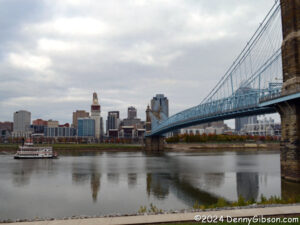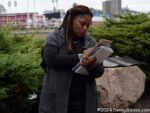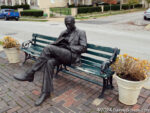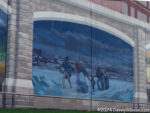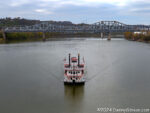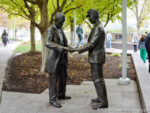I took this Harriet Beecher Stowe House walking tour last Saturday with the idea that it would be the subject of last Sunday’s blog post but it was not. I told myself there wasn’t enough time to create a post for Sunday morning, which was certainly one reason, but another reason was that I felt slightly disappointed in the tour. I should not have. The problem was my expectations were off. For no good reason, I had thought we would visit spots where historic things happened but with just a little more thought I realized how ridiculous that was—the Cincinnati riverfront of 2024 bares little resemblance to the riverfront of the past. The tour took us to places where historic things are commemorated. I enjoyed the tour as it happened and now appreciate it with the passage of a little time.
We met tour guide Zinnia Stewart by the statue of John Roebling near the south end of the bridge that bears his name. Other than a meeting point, the statue plays no role in the tour. Neither does the bridge as anything other than a walkway across the river. I chose the particular opening photo that I did because it mimics the photo that has appeared at the front of this blog since the beginning. Its purpose is to show the river of the tour’s title. Dredging, dams, and other feats of engineering have made the Ohio River consistently navigable for large barges which is something it was not in the days when it separated the free North from the slaveholding South.
The tour began by heading east along the river to a statue representing James Bradley. We were supplied with small wireless (Bluetooth I assume) listening devices so that we could easily hear Stewart as we walked. Bradley was abducted from Africa and worked as a slave until he was able to buy his own freedom in 1833. He then moved to Cincinnati and was the only former slave participating in the pivotal Lane Debates of 1834.
We then headed west past the Roebling Bridge to the string of Robert Dafford murals on the riverfront and stopped at The Flight of the Garner Family. In 1856, Margaret Garner escaped from slavery by crossing the frozen Ohio River with her husband and children. They were captured in Cincinnati and Margaret killed her daughter to save her from a life of slavery. She was prevented from killing herself and her other children as planned. Toni Morrison’s Beloved was inspired by these events.
It was now time to cross the river ourselves. I had taken that opening picture of the River Queen during our visit to the murals and now caught it from the middle of the Roebling Bridge after it turned and headed back. We stopped twice while crossing as Stewart shared stories and photos of people and places along both sides of the river.
On the Ohio side, I spent more time at the Black Brigade Monument than I have ever spent before, and as a result, I know I need to spend a lot more time here in the future. I simply did not realize the many facets of this monument that it seems I’ve only glanced at before. One bit of information that made the whole tour worthwhile is that William Mallory, who was instrumental in getting the monument constructed, was the model for the face of Black Brigade member Marshall P.H. Jones. I thought I knew the story of the Black Brigade but, just like the memorial, there is a lot more for me to learn.
 Our last stop was at this statue of politician Marian Spencer. Spencer left her mark on the area in many ways but she is probably best remembered for her efforts to desegregate Coney Island Amusement Park.
Our last stop was at this statue of politician Marian Spencer. Spencer left her mark on the area in many ways but she is probably best remembered for her efforts to desegregate Coney Island Amusement Park.

